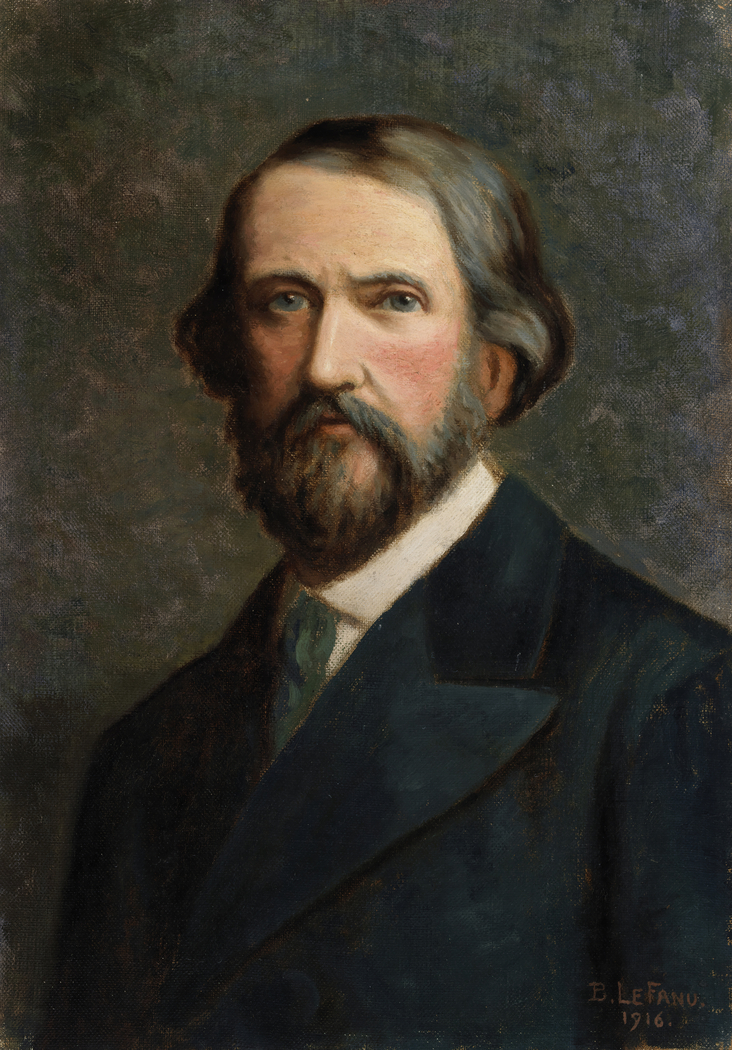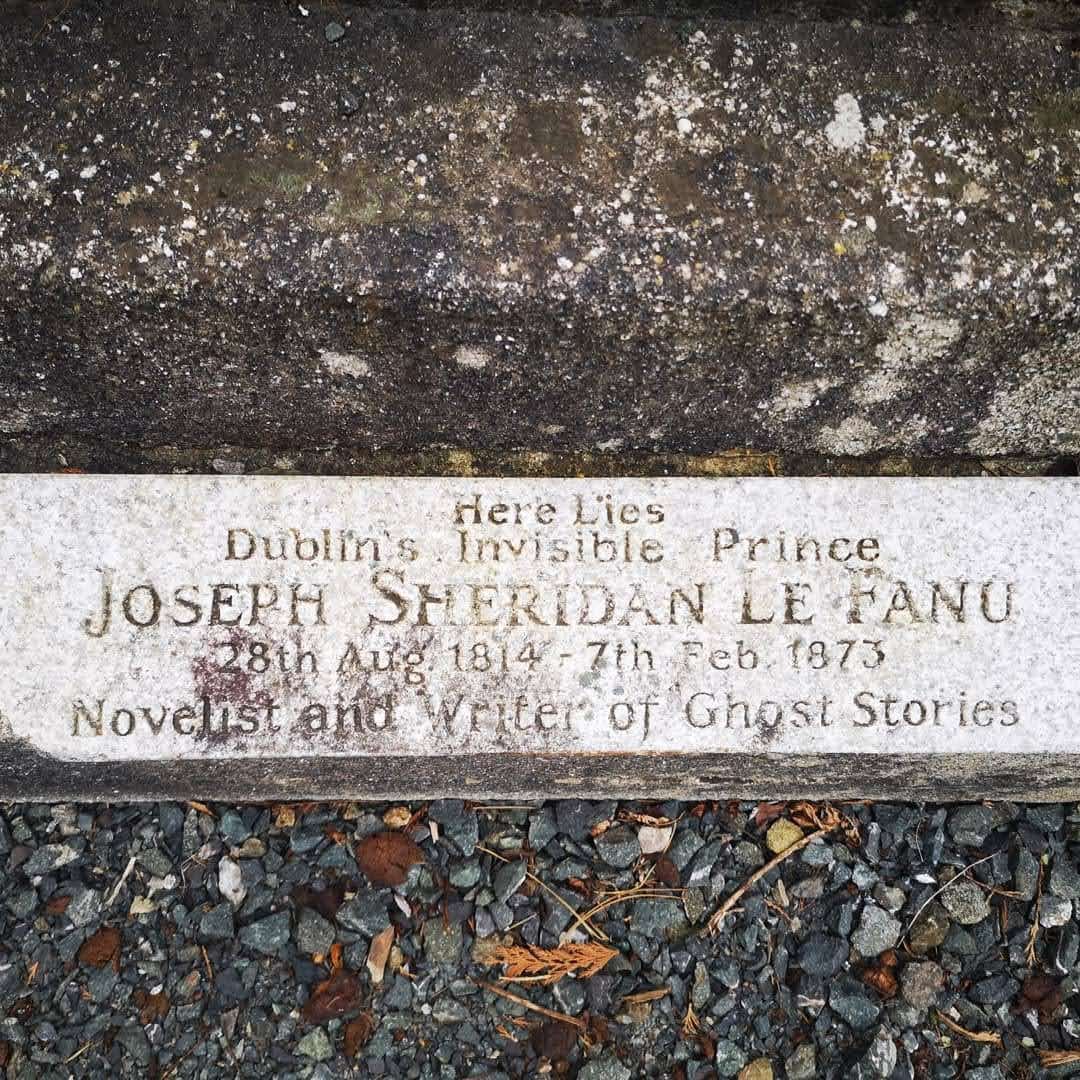
Joseph Sheridan Le Fanu
28 August: Joseph Thomas Sheridan Le Fanu born in Dublin. His father was a Dean of the Church of Ireland and his mother was a writer. Both his grandmother (Alicia Sheridan Le Fanu) and his great-uncle (Richard Brinsley Sheridan) were playwrights. The latter is rightly the most famous of the lot, for such works as The Rivals and School for Scandal.
Thomas Philip Le Fanu (JSLF's father) is appointed Chaplain of the Royal Hibernian Military School (founded to educate orphaned children of members of the British armed forces in Ireland). So the Le Fanu family moves to the school grounds, in Phoenix Park, about a mile west of Dublin. The Park, the adjacent village, and the parish church of Chapelizod will later appear in JSLF's fiction.
The family moves to Abington, County Limerick, when Thomas is appointed Dean of Emly and Rector of Abington. JSLF and his brother William are educated by a tutor, who was eventually fired for incompetence. JSLF read widely in his father's library
JSLF begins writing poetry, reading his work to his mother and his siblings, but not his father.
The Tithe War (1830-1836) begins to have a significantly negative affect on the Le Fanu family finances. This was a primarily nonviolent campaign of civil disobedience (that sometimes gave way to violent uprisings) by Catholics who resented being forced to give 10% of their earnings to support a church they did not believe in.
There are fewer than 100 members of the Church of Ireland in Abington, and over 6,000 Catholics within the diocese. The increased income from those tithes was one of the reasons why Thomas accepted his position. But in 1830 the amount of tithes begins to decrease, , until in 1832 Thomas received no tithes at all.
Violent incidents associated with the Tithe War begin to happen in and around Limerick. Such uprisings were late in coming to Limerick, but when they did, the Dean and his family were in grave danger.
The family returns to Dublin.
JSLF enters Trinity College to study law.
From 1838 to 1840, JSLF publishes a dozen stories in the Dublin University Magazine. They are mostly set in Ireland and include several Gothic horror stories, with dark haunted castles, visitations from ghosts, madness, and suicides. There is also a tone of melancholic nostalgia for pre-Plantation Ireland, before the Catholic aristocracy had their lands stripped from them. The ruins of the castles from that time serve as settings for many of these stories. The stories are later collected as The Purcell Papers (1881)
JSLF enters the bar, but never practices law.
JSLF purchases several small newspapers, including the Dublin Evening Mail and The Warder.
An anonymous novella, Spalatro: From the Notes of Fra Giacomo, is published in the Dublin University Magazine. In 1980, W. J. McCormack's biography of JSLF recognizes it as Le Fanu's work. The main character has a necrophilic desire for a beautiful, undead, blood-drinking woman, who seems to be a predecessor of Le Fanu's later female vampire Carmilla. Like Carmilla, this undead creature is not presented in a negative light, and even attempts (but fails) to save Spalatro from the eternal damnation that seems to be his destiny.
JSLF marries Susanna Bennett. They move into a house near the Grand Canal in Dublin. They will have four children
A daughter, Eleanor, is born. The couple will have four children: Eleanor, Emma (b. 1846), Thomas (b. 1847) and George (b. 1854).
JSLF's first novel, The Cock and Anchor, is published. His early novels are historical fictions in the style of Walter Scott.
The Fortunes of Colonel Torlogh O'Brien, another historical novel, is published.
Joins with John Mitchel and Thomas Francis Meagher in their campaign against the indifference of the government to the Irish Famine.
Susanna's parents retire to live in England, and the family move into their house at 18 Merrion Square (later number 70, the office of the Irish Arts Council). JSLF never owned the house, but rented it from his brother-in-law for £22 / year, which he failed to pay in full).
Susanna begins to suffer from extreme anxiety and neurosis. This brought great grief to Le Fanu, who refused to write fiction again until his mother died three years later in 1861.
Susanna dies. JSLF gives up writing.
JSLF's mother dies, and after her death he becomes, for all intents and purposes, a recluse. But he takes up writing again, rumored to write only at night, by the light of two candles. He is known around Dublin as "The Invisible Prince."
JSLF purchases and becomes the editor of the Dublin University Magazine where he serializes his short stories.
The House by the Churchyard, the last of Le Fanu's historical novels, and the last set in Ireland, is published. It is set in Chapelizod, where Le Fanu lived as a child, and was cited by Joyce in Finnegans Wake. This work begins to move toward the Gothic, but instead of the traditional Gothic focus on external horrors, Le Fanu mixes Gothic conventions with psychological horror.
Le Fanu's Gothic period: Wylder's Hand (1864), Guy Deverell (1865), The Tenants of Malory (1867), The Green Tea (1869), The Haunted Baronet (1870), Mr. Justice Harbottle (1872), The Room in the Dragon Volant (1872) and In a Glass Darkly (1872).
The last is his best-known work, a collection of five long stories, including "Carmilla." This work greatly influenced Bram Stoker’s Dracula, published twenty-five years later:
- first-person narration
- physical descriptions (Stoker’s Lucy looks just like Carmilla)
- fascination with sexuality (Lucy and Carmilla are both lesbians)
- character types (Stoker’s vampire hunter Abraham Van Helsing owes a debt to Le Fanu’s vampire expert Baron Vordenburg)
Later suppositions about Le Fanu's skills were that his experience with Susanna's mental health enabled him to infuse supernatural stories with psychological insight. Phenomena in his stories could potentially have natural explanations, but he is deliberately ambiguous, leaving readers to determine those explanations on their own.
7 February: Le Fanu dies of a heart attack in his house on Merrion Square. He is buried in Saint Jerome Cemetery in Dublin, where his tombstone reads "The Invisble Prince."
